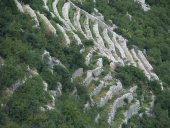I've spent a lot of time lately thinking and researching about Terlingua, Texas. There is a ranch there with vast areas of inexpensive land with no restrictions and surrounded by millions of acres of Chihuahuan desert wilderness, including big bend national park. seems like a drylands paradise waiting to be made.
part of this was researching dry adapted species.
many of these would probably grow there, a few may need higher winter temps (Terlingua is around zone 9) or a bit more precipitation (Terlingua area gets 10-18"/year average depending on elevation mainly)
I was watching a couple of bill mollison videos and he talked about an abundant dryland drought proof treed system for even true deserts (less than 10" precip /year)
anyway here goes the incomplete list, a mix of latin and common names, some genus without species, etc. based on the mollison videos and some of my own research
drylands species list
acacia
opuntia
prosopis
ficus platypoda
desert oak quercus palmeri
ficus sycomorus
Tylosema esculentum--(a perennial desert bean drought proof hemsbach bean-giant bulb)
Hylocereus (pitaya)
Calochortus nuttallii (sego lily)
jujube
Carnegiea gigantea (saguaro cactus)
banana yucca
carob
honey locust
parkia genus
Washingtonia filifera (desert palm)
sabal mexicana, texana (mexican/texan palm)
ensete ventricosum (frost tender)
inga
inside tree mulch basins- comfrey, sweet potato
mulberry
fig
pistachio
pomegranate
grapes
passion fruit
oyster nut telfairia
choco / chayote
kiwi
seed new swales with
wooly vetch
lupine
sorghum
millet
sunflower
clover
sweet potato
mint
cassava
buckwheat
japanese millet
finger millet
teff
cucurbita foetidissima- buffalo gourd, seeds were used as a staple by native americans in texas
cucurbita pepo and moschata are north american natives
Lagenaria siceraria
cucurbita ficifolia
cucurbita maxima, mixta
phaseolus acutifolius (tepary bean- s.w. usa native desert adapted annual edible bean)- grown with beans and squash traditionally
olneya tesota (desert ironwood)
palo verde
lycium cooperi
lycium andersonii
Symphoricarpos longiflorus
http://www.beattymuseum.org/plants.html this site has some plants used by usa southwest natives
http://foodplantsolutions.org/wp-content/uploads/2015/07/Potentially-Important-Food-Plants-of-Pakistan-v1.pdf this is a document about food plants that could be used in pakistan
http://foodplantsinternational.com this site has an awesome searchable database of over 27,000 food plants, you can search in many ways other than just name, like you can search for plants that grow in arid regions, etc. although with my browser today i was only able to pull up the complete alphabetized plant list
also there are some PDFs published based on this database for various countries, such as the one for Pakistan, above, which seems to have areas that would be climate analogues of Texas. Africa seems to have many good little known species, also

 2
2








 1
1
















 2
2




 1
1




 1
1















